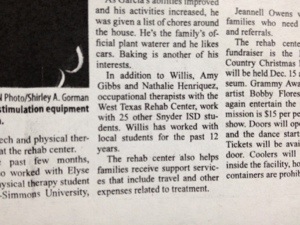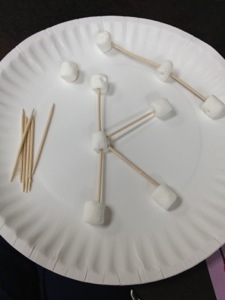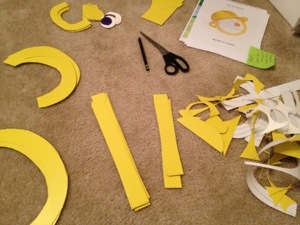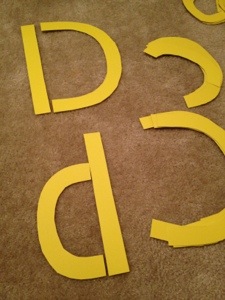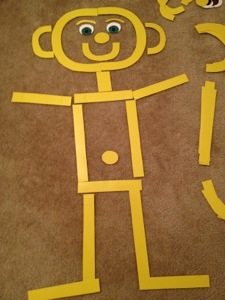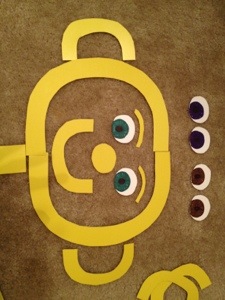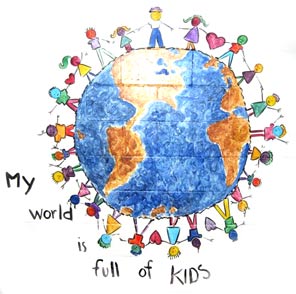Hello! I have to brag a minute. A patient I see was featured in his local newspaper. It was a great article and I wish I could post the whole thing! It really advocated for OT, PT, and treatment in the schools. He described what his OT does with him (that’s me!), and stated his favorite therapy is when he gets to move his hand! He is a great young man and a joy to work with! Great stuff!
TheraTogs Wunzi
5 JanHiya everyone! New and cool stuff I thought I’d share with everyone. Most pediatric therapists have either heard of TheraTogs or used them in their practice. TheraTogs has released a new design specifically for early intervention, the TheraTog Wunzi!
Most parents of infants with low muscle tone and delayed motor development hear reassurances from their pediatrician; however, sometimes infants do need more help to assist their postural and motor development.
TheraTogs highlighted 3 urgent needs for infants with developmental deficits:
1. Optimizing sensory input and body awareness
2. Establishing strong core alignment and postural control
3. Engaging in “massed practice” of optimized performance to gain improved function
The inventor of TheraTogs stated, “Babies with sensory and motor issues can’t wait for their difficulties and deficits to become so obvious that pathomechanical strategies and habits are established.”
How often do I see that?? Statements such as, “They’ll grow out of it,” or “Maybe they are just slower than the typical baby,” or “Let’s wait and see what they look like in 6 months.” As a pediatric therapist, I know how important it is to provide early postural and neuromotor development before compensatory strategies develop.
The Wunzi is available in 5 sizes for children 0-24 months. It is designed similar to the traditional “onesie” and therefore requires very little training on how to put on the garmet. There are no buttons, zippers, or snaps; only embedded closure tabs of Velcro. A Limb Kit is sold separately to include limb positioning cuffs and straps to promote age appropriate limb alignment and function.
Now, how do we get insurance to pay for them?! Research!

For more information, visit their Web site: http://www.theratogs.com/Wunzi.aspx
You Might be a Pediatric Therapist if…
3 Jan1. You know NDT isn’t a wrestling move
2. You know SI doesn’t mean sports illustrated
3. You ask friends and spouses if they need to go “potty”
4. You get really good at spelling words like ” candy, mom, and playground” so kids don’t hear
5. You’ve found crayons and highlighters in your laundry
6. You save random household products to use for “therapy tools”
7. You shop for toys for yourself
8. You refer to your patients as your “kids”
9. You know Hippotherapy doesnt involve hippos
10. You impact the lives of children and their families to enhance their independence and development in order for them to grow and learn.
Leave me comments with more!!
Toy Tuesday: Player’s Choice
1 JanHi there! I was going through the mail and stumbled across an edition of the Advance For OT Practitioners magazine. The featured article on the front caught my eye and was titled, “Players choice: Picking Toys to Help Children Learn and Grow.” The article did a great job discussing the views of a pediatric PT, parent, and representative from Toys R Us when it comes to picking out toys for kids. Some things were similar but some things were very different and kind of surprised me! I don’t tend to look for where and what toys are made of but it was important to the parent. It will be interesting if that changes for me once I have my own kids!
My favorite part of the article was the link given by the TRU rep: http://www.toysrus.com/differently abled
Toys R Us has a link with different resources for differently abled kids including safe play tips, ten tips for buying toys, and a list of toys identified by 10 different categories to build various skills. These categories include: auditory, language, visual, tactile, gross motor, fine motor, social skills, self esteem, creativity, and thinking. I also really enjoyed reading the top ten tips for buying toys:
1. Multi-sensory appeal
2. Method of Activation
3. Environments the toy will be used
4. Opportunities for success
5. Current popularity
6. Self-expression
7. Adjustability
8. Child’s individual abilities
9. Safety and durability
10. Potential for interaction
Check out the website for more details. Also check out the website for a great list of safe play tips.
For over 20 years, Toys R Us has released this publication for parents. It’s awesome! Hope you enjoy!
Fine Motor Friday: Marshmallows and Toothpicks
9 NovHello hello! Time for Fine Motor Friday! For this week I will be sharing one of my most favorite things to do with marshmallows and toothpicks! It can be used with a multitude of ages, as young as around 4 to as old at you feel appropriate (each client has different likes/skills). The oldest I’ve used this activity with was a 15 year old. 🙂
Supplies:
Bag of mini marshmallows
Box of toothpicks
Extras if desired:
Paper plates to hold supplies
Pictures/ideas to copy and construct
I came up with some ideas to have the kids I work with copy, varying from simple to more difficult on the back (including a complex 3D cube!). I placed mine in a sheet protector to keep it from getting sticky! Have the child copy the pictures, guiding, imitating, and provides cues as needed. Another fun thing to use this activity for is brainstorming new designs using higher level executive function skills.
Fun, sticky, educational, and great for developing fine motor and visual perceptual skills!
Caution: some children will want to eat them…some therapists may want to eat them too… 🙂
Enjoy!
<a href="https://littlehandslovebig.files.wordpress.com/2012/11/20121105-204630.jpg”>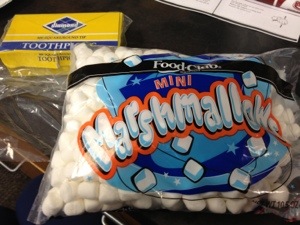
<a
You Might Be An OT If…
6 Nov1. PROM no longer means high school dance
2. Your available ROM has nothing to do with your computer
3. You know that occupation is more than a job
4. You diagnose yourself with every new condition you know.
5.You have to explain what you do for a living.
6. You know that playing games is a part of therapy.
7. You use shorthand when writing emails or text messages
8. You know that OT does not mean Over Time
9. You attempt to guess the diagnosis/disability of strangers
10. You focus on helping people achieve independence in all areas of their lives.
Love this! Can you think of any more????
Super Duper Handy Handouts & OTis
1 OctI absolutely love free, awesome, printables…yes, I said free! These handouts are great for brief education to parents, caregivers, and teachers. I keep a copy of the ones I use the most in clear sleeves in a binder. Then I can just send it through the copier when I want to give it to someone.
http://www.handyhandouts.com/search.aspx
Handy Handouts are a component of Super Duper Inc., a great place to purchase toys, games, and other learning materials.
One of my favorite, and very unique, things off of this Web site is the Yogarilla Exercise and Activities Card Deck. OTis, the OT gorilla, teaches traditional and original yoga poses in an exciting way! 55 yoga poses, color-coded by starting positions, and 110 activities compile this colorfully illustrated card deck. Yoga has been shown to help children understand how their bodies and minds work together. The yoga poses (10 standing, 10 seated, 10 prone, 10 spine, and 10 hands and knees) help to improve fine and gross motor skills, sensory processing, attention, communication, and cognition. Also included are: 3 partner poses (two children work together in a pose) and 2 breathing poses (improve awareness of breath and breath support). Check it out! All I need to go with my cards is a stuffed toy Gorilla in an OT t-shirt!

http://www.superduperinc.com/products/view.aspx?pid=OTSC8609#.UGjxjo7R1FI
Hope you enjoy!
~Amy
Mat Man!
29 SepOne of my favorite ways to teach body awareness and drawing a picture of a person with a body (versus a head with arms and legs 😉 is the Handwriting without Tears Mat Man! If you’ve never heard of Handwriting without Tears (HWT) check it out at: http://www.hwtears.com. HWT is a handwriting curriculum developed by an OT using a hands-on, educationally sound instructional method to teach handwriting. It is composed of several workbooks, teaching manuals, educational materials such as flash cards, CDs, and different types of paper. The curriculum also has an assessment, The Print Tool, used to evaluation and remediate capital letters, lower-case letters, and numbers. HWT has been adopted by the Texas State Board of Education, and meets TEKS standards for Language Arts. The workbooks have even been translated into Spanish, French, and Hebrew! How cool is that? Maybe I should purchase the Hebrew book for myself. I’ve always wanted to learn how to write Hebrew!
Anyways, one of the HWT programs is called, Get Set for School. It’s primarily based for pre-K to K kids for pre-writing, letter recognition, proper letter formation, and other developmentally appropriate activities to allow the child to be ready for Kindergarten. One of the tools used with this program is the wood pieces set (http://shopping.hwtears.com/product/WP/GSS). It has big lines, little lines, big curves, and little curves that are used to teach basic letter formation, recognition, and memory. In the teacher’s manual there is a pattern to create your own wood pieces set. I used this pattern to create a set of wood pieces on poster board. I chose the color yellow so the letters would be bright!
HWT encourages the wood pieces also be used to make mat man! The Get Set for School even has a nice little song to sing while you build mat man. Sing along with the song, if your voice is good enough and the child doesn’t ask you to be quiet. This happens quite a bit in my treatment sessions. I decided to make some facial features for my version of mat man. I made 2 of each: blue, green, and brown eyes, so the child can pick out the same color eyes he has. I made a mouth, nose, and even some eyebrows. You can even give mat man a belly button! Now all I need to do is make him some hands and a variety of hats to wear and then he will be complete! I may have a few of my kiddos help me with this task. Then they can work on tracing their hand and cutting! Creating a list of hats will also help with higher level thinking processes including imagination and role playing.
Other fun ways to modify this activity include: making the poster-board pieces even smaller, perhaps using an index card; use puff paint on the pieces in order to trace with index finger and create a tactile feedback for letter formation; Put velcro/magnets on the back of the pieces in order to use on a vertical surface or while swinging. Can you think of any other activities using the wood pieces?
Check out the app too! http://wetdrytry.com/
Now go have some fun and learn your letters! 🙂
~Amy
Pathways
23 SepHad to share the link to this wonderful foundation. Their website is full of wonderful information and resources for professionals and parents. Check it out!
http://www.pathwaysawareness.org/
How cool is this?!?! A baby milestones and weekly activities calendar!
http://pathways.org/awareness/parents/new-parents/monthly-milestones-and-activities-calendar/
*AMY*
How Does Your Engine Run?
23 SepThe Alert Program is a one-of-a-kind program that allows children, teachers, parents, and therapists to choose appropriate strategies in order to change or maintain states of alertness. Children, teachers, parents, and other educators, are taught how to recognize when their nervous system is in a low or high alert state and then provides knowledge on what they can do to help regulate that nervous system to facilitate the optimal state based on the need (environment, demands, time of day, etc.)
“Leaders of the program not only learn what they can do to support self-regulation, but how to share the underlying theory so all can understand the basics of sensory integration. By reading the book or attending a conference, adults increase awareness of their own self-regulation thereby improving their ability to facilitate students’ optimal functioning. The Sensory-Motor Preference Checklist (for Adults) is a tool used to support this learning process. For example by filling out the checklist, adults may discover that before work, they may drink coffee, take a brisk walk, or listen to jazzy music to get their engine up and going for the day. Or others may find that they drink hot chocolate, rock in a rocking chair, or watch the glow of a fireplace to get their engine slowed down after a busy day. Bringing to awareness what most people do automatically in their daily routines, fosters the understanding of how important self-regulation is for students’ functioning.”
Initially, the Alert Program was intended for children with attention and learning difficulties, ages 8-12. However, it has now been adapted for preschool through adult along with for a variety of disabilities. Due to the concepts taught in the program, if children are intellectually challenged or developmentally younger than the age of eight, the information gained can be utilized by staff to develop sensory diets (Wilbarger & Wilbarger, 1991) in order to enhance learning.
What is self-regulation?
“Self-regulation is the ability to attain, change, or maintain an appropriate level of alertness for a task or situation” (Williams & Shellenberger, 1996). Having the ability to change how alert we feel is the foundation of every goal a parent, teacher, or therapist has for their children (or adult clients).
If we are in a low state of alertness (lethargic or “droopy”), we are not ready to learn. Likewise, if we are in a high state of alertness (hyper or overly active), learning is more difficult. Through the Alert Program, self-regulation strategies are offered in order to attain an optimal state of alertness. The goal is to set up the nervous system for success and be ready to learn and achieve goals.
Why the engine analogy?
The Alert Program uses an engine analogy because many children can relate and learn quickly about self-regulation when talking about their “engine” going into high, low, or just right gears. The engine analogy is just one way, but by no means the only way, to describe how alert one feels. Other descriptors might include:
- colors (red for high, yellow for low, green or blue for just right
- animals (maybe cheetah for high, turtle for low, and bear for just right)
- Winnie the Pooh (Tigger for high, Eyore for low, and Pooh for just right)
- Use the child’s special interest, especially if on the Autism Spectrum. (For example, if the child loves to talk about a certain movie then use characters from that movie.)
- Adults might use the words, “high alert, low alert, and just right for ___ (fill in the blank for any activity)”
- Children who are more concrete thinkers might do better with actual photos taken when they are in high, low, or just right states of alertness.
Reference: http://www.alertprogram.com
Personal thoughts: I myself have the Alert Program resources and have completed the distance learning program to earn CEUs towards my license. I think it is a fabulous program with applicable and thorough information. It provides descriptions in an easily understandable method and has great tools for teachers and parents. Have you used the Alert Program in your treatment sessions? How did it work for you?
Children’s Book Shout Out:
Images courtesy of: http://www.aapcpublishing.net/
Your First Source for Practical Solutions for ASD (Autism-Spctrum Disorder) as well as sensory processing deficits, self-regulation, behavior, academics, vocational skills, and more!
Scholarly articles supporting the use of The Alert Program for evidence-based practice
School-Based Practice Moving Beyond 1:1 Service Delivery. Edited by Yvonne Swinth and Barbara Hanft. Sept. 16, 2002. http://www.aota.org/Pubs/OTP/1997-2007/Features/2002/f-091602_1.aspx?css=print
Autism Spectrum Disorders: Integrating Methodologies and Team Efforts. Tammy Sarracino, Lynn Dell, Sherry Milchick. Jan. 14, 2002, http://www.aota.org/Pubs/OTP/1997-2007/Features/2002/f-011402_1.aspx
Neurocognitive Habilitation Therapy for Children With Fetal Alcohol Spectrum Disorders: An Adaptation of the AlertProgram. American Journal of Occupational TherapyJanuary/February 2012vol. 66 no. 1 24-34
For a list of research articles please visit: http://www.alertprogram.com/research.php and contact The Alert Program.
~Amy


